Catalogue: England
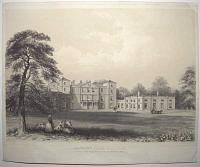
Langley Park, Norfolk. The Seat of Sir William Beauchamp Proctor Bar.t.
E.F.P. [Payne?] del et lithog. Printed by Hullmandel & Walton.
[n.d., c.1850.]
Rare tinted lithograph. Sheet 340 x 420mm (13½ x 16½"). Trimmed within printed border at sides, inscription area with repaired cracks and tear, top right corner cracked.
The facade of the 18th century Palladian hall built by Matthew Brettingham, set in a landscape park attributed to Lancelot 'Capability' Brown. It is now home to Langley School. The print predates Sir William changing his surname to Proctor-Beauchamp in 1852.
[Ref: 62171] £130.00
(£156.00 incl.VAT)
![[Lewes Priory, Sussex] Confirmatio Radulfi de Pleiz Monachis sci Pancratii de Ecclesia et Terris in Iford &c. [Com: Sussex] in libera elemosina. circa tempus R. Stephani.](img-thumbnail/jpegs/24891.jpg)
[Lewes Priory, Sussex] Confirmatio Radulfi de Pleiz Monachis sci Pancratii de Ecclesia et Terris in Iford &c. [Com: Sussex] in libera elemosina. circa tempus R. Stephani.
Ex Autographo [sigillo carente] penes Ric: Rawlinson, L.L.D. Oxon R.et AT.S.S. 1754.
Engraved facsimile of a c.1150 Latin grant of land at Iford, East Sussex to the Priory of St Pancras. Watermarked laid paper, 200 x 160mm, 8 x 6¼". A good impression with wide margins.
A frankalmoigne: a tenure by which a religious corporation holds lands given to them and their successors forever, usually on condition of praying for the soul of the donor and his heirs - called also tenure by free alms. The Priory of St Pancras was the first Cluniac house in England and had one of the largest monastic churches in the country. It was set within an extensive walled and gated precinct laid out in a commanding location fronting the tidal shore-line at the head of the Ouse valley to the south of Lewes. The Priory was endowed with churches and extensive holdings, such as this one, throughout the country. The original document is from the collection of Richard Rawlinson (1690 – 1755), a clergyman and antiquarian who bequeathed a huge collection of books and manuscripts to the Bodleian Library, Oxford. In 1716 he was ordained, but as he was a nonjuror and Jacobite, the ceremony was performed by a nonjuring bishop, Jeremy Collier. In 1728 he became a bishop, but seems to have preferred to pass his time in collecting books and manuscripts, pictures and curiosities, rather than in discharging his episcopal functions. At his death Rawlinson left to the Library 5,205 manuscripts bound in volumes that include many rare broadsides and other printed ephemera, his curiosities, and some other property that endowed a professorship of Anglo-Saxon at Oxford. The Rawlinsonian Professor of Anglo-Saxon was first appointed in 1795. He was also a benefactor to St John's College, Oxford.
[Ref: 24891] £140.00
(£168.00 incl.VAT)
![[Croxden Abbey, Staffordshire] Carta Abbatiae de Croxton in Com. Stafford, fundatae anno Dom. MCLXXIX [1179].](img-thumbnail/jpegs/24716.jpg)
[Croxden Abbey, Staffordshire] Carta Abbatiae de Croxton in Com. Stafford, fundatae anno Dom. MCLXXIX [1179].
penes Ric. Rawlinson, LLD. SRS. MDCCXLIII [1743]. [British, c.1750s.]
Engraved facsimile of the Latin foundation charter of Croxden Abbey, Staffordshire. Single folding plate, 505 x 235mm, 20 x 9¼". Centrefold splitting; some soiling and staining. Extremities frayed and chipped; small portion of text detached from upper right, hole upper left.
Bertram de Verdun of Alton Castle made a grant of land in 1176 at a place called Chotes to the Cistercian monks of Aunay-sur-Odon in Normandy, as the site for a new abbey. "Chotes" has been identified as Cotton, close to Alton, Staffordshire. The monks of "Chotes" moved to Croxden in 1179. The monastery was styled as the Abbey of the Vale of St Mary of Croxden and was dedicated in 1181. Wax seal to lower part. The original documents are from the collection of Richard Rawlinson (1690 – 1755), a clergyman and antiquarian who bequeathed a huge collection of books and manuscripts to the Bodleian Library, Oxford. In 1716 he was ordained, but as he was a nonjuror and Jacobite, the ceremony was performed by a nonjuring bishop, Jeremy Collier. In 1728 he became a bishop, but seems to have preferred to pass his time in collecting books and manuscripts, pictures and curiosities, rather than in discharging his episcopal functions. At his death Rawlinson left to the Library 5,205 manuscripts bound in volumes that include many rare broadsides and other printed ephemera, his curiosities, and some other property that endowed a professorship of Anglo-Saxon at Oxford. The Rawlinsonian Professor of Anglo-Saxon was first appointed in 1795. He was also a benefactor to St John's College, Oxford.
[Ref: 24716] £90.00
(£108.00 incl.VAT)
![[Land grant, Cheshire] Carta Donationis Terrarum in Congilton [Com: Cestriae] a Dno Henrico de Lacy Comite Lincoln Benedicto Filio Walteri de Stanley.](img-thumbnail/jpegs/53132.jpg)
[Land grant, Cheshire] Carta Donationis Terrarum in Congilton [Com: Cestriae] a Dno Henrico de Lacy Comite Lincoln Benedicto Filio Walteri de Stanley. circa Annum 1300.28.Ed.1.concessa.
(maxima preservacoe) penes Ric: Rawlinson, LLD et RSS. [British, c.1754].
Engraved facsimile of a c.1300 Latin grant of land to Henry de Lacy, 3rd Earl of Lincoln; seal below text. Sheet 210 x 230mm, (8¼ x 9"). Tears and holes, trimmed. Damaged.
The land around Congleton in Cheshire is granted by the de Stanley family to the powerful nobleman de Lacy, who became Chief Councillor to Edward I. While the king was engaged on military conflicts with the Scots, Henry de Lacy was appointed Protector of the Realm. The original document is from the collection of Richard Rawlinson (1690 - 1755), a clergyman and antiquarian who bequeathed a huge collection of books and manuscripts to the Bodleian Library, Oxford. In 1716 he was ordained, but as he was a nonjuror and Jacobite, the ceremony was performed by a nonjuring bishop, Jeremy Collier. In 1728 he became a bishop, but seems to have preferred to pass his time in collecting books and manuscripts, pictures and curiosities, rather than in discharging his episcopal functions. At his death Rawlinson left to the Library 5,205 manuscripts bound in volumes that include many rare broadsides and other printed ephemera, his curiosities, and some other property that endowed a professorship of Anglo-Saxon at Oxford. The Rawlinsonian Professor of Anglo-Saxon was first appointed in 1795. He was also a benefactor to St John's College, Oxford.
[Ref: 53132] £70.00
(£84.00 incl.VAT)
![Lavenham [pencil.]](img-thumbnail/jpegs/11649.jpg)
Lavenham [pencil.]
M. Douglas. [pencil signature.]
[n.d., c.1920.]
Etching. 225 x 150mm, 9 x 6".
The C15th church of Lavenham in Suffolk, paid for by wool-wealth, with the highest church tower in England at 141 ft (43 m).
[Ref: 11649] £60.00
(£72.00 incl.VAT)
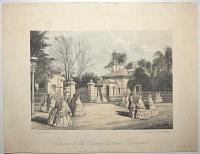
Entrance to the Jephson Gardens, Leamington.
J.A. Spencer, Photo. John Lane & Co Lith. London.
London, Published for the Proprietors by Kelly & C.o. [n.d., c.1850.]
Rare tinted lithograph. Sheet Sheet 215 x 280mm (8½ x 11").
A view of the Lodge Entrance to Jephson Gardens, a formal gardens in Leamington Spa.
[Ref: 60792] £140.00
(£168.00 incl.VAT)
![[In ink:] The Regents Hotel Leamington.](img-thumbnail/jpegs/19111.jpg)
[In ink:] The Regents Hotel Leamington.
[n.d. c.1860.]
Engraving. 90 x 121mm. 3½ x 4¾".
South and West views of the Regent Hotel Royal, Leamington Spa. In 1849 another Parade entrance was added to the west side. Queen Victoria stated at the Regent Hotel when she visited Leamington Spa in 1830.
[Ref: 19111] £35.00
(£42.00 incl.VAT)
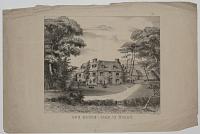
Lee House - Isle of Wight.
J. Aresti, Litho.
[n.d. c.1850.]
Lithograph, rare. 248 x 375mm. 9¾ x 14¾". Tear into title area; creasing.
Lee House, a Tudor cottage near Colwell Bay, Isle of Wight.
[Ref: 25004] £110.00
(£132.00 incl.VAT)
![Leeds from the Nostrop Road._ [in pencil.]](img-thumbnail/jpegs/15099.jpg)
Leeds from the Nostrop Road._ [in pencil.]
Le Keux 2" 1715 from Housby's Leeds Yorkshire. [in pencil.]
[n.d. c.1870.]
Unfinished engraving. Rare proof. 279 x 432mm. 11 x 17".
Knowsthorpe, Knostrop or Knostropp is an area of Leeds, on the River Aire. This panoramic view looking back from Knostrop to the town centre of Leeds.
[Ref: 15099] £190.00
(£228.00 incl.VAT)

Cloth Hall, Court House. &c. From Park Row, Leeds.
Engraved by H. Adlard, from a Drawing by R.D. Chantrell, Architect.
Published by Robinson & Hernaman, Leeds. [n.d. c.1830.]
Engraving. 209 x 324mm. 8¼ x 12¾".
Central scene, Leeds.
[Ref: 15119] £120.00
(£144.00 incl.VAT)

Plan of the Town of Leeds. with the Recent Improvements. Surveyed in 1821 by Cha.s Fowler, Leeds. Engraved for the Yorkshire Directory.
Nelle & Son, 352 Strand.
Published by Edw.d Baines Leeds 1821.
Engraved map, 1820 watermark. 250 x 350mm (9¾ x 13¾"). Splits in binding folds taped.
Plan of Leeds with a 54-point key and an inset ''S.E. View of the Philosophical & Literary Society's Hall''.
[Ref: 56094] £80.00

Entrance of Leeds - Castle, Yorkshire.
Published July 1st, 1797 by V. & R. Green No. 14 Percy Street, Bedford Square, London.
A rare aquatint printed in green. 440 x 280mm 17¼ x 11inches. Trimmed to plate attached by 4 corner to old album page.
Title incorrect and should read Kent, as has been written in pencil in title area.
[Ref: 11311] £260.00
(£312.00 incl.VAT)
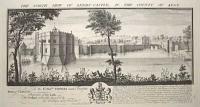
The North View of Leeds - Castle, in the County of Kent. To the R:t Hon:ble Thomas Lord Fairfax Baron of Cameron, Proprietor of this Castle, This Print is humbly Inscrib'd by his Lordships most Obed:t Serv:ts Sam.l & Nath.l Buck.
S. & N. Buck del et scu. 1735.
Engraving. 195 x 375mm (7¾ x 14¾").
A view of Leeds Castle, southeast of Maidstone, on a lake on the River Len. The owner at the time was the grandson of Sir Thomas Fairfax of Civil War fame. From the series of 'Antiquities' by brothers Samuel (1696 - 1779) and Nathaniel Buck (1727 - 1753; fl.c.).
[Ref: 56385] £160.00
(£192.00 incl.VAT)
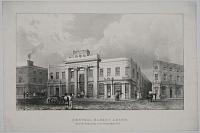
Central Market Leeds.
Printd. & Published by T. Inchbold, Lithogr. Leeds. [n.d. c.1830.]
Rare lithograph. 190 x 280mm. 7½ x 11". Fine.
Leeds Central Market (1824-1827), architect Francis Goodwin.
[Ref: 15117] £110.00
(£132.00 incl.VAT)
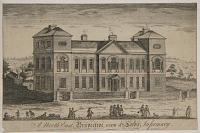
A North East Perspective View of Leeds Infirmary.
Sunderland delin, et sculp.
Copper engraving, very scarce. 197 x 298mm. Cut.
[Ref: 15120] £160.00
(£192.00 incl.VAT)
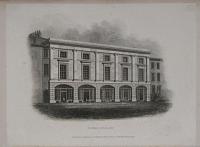
Leeds Library.
T. Taylor, del. J. Le Keux, sc.
Published by Robinson, Son & Holdsworth, Leeds, & J. Hurst, Wakefield, March.1.1815.
Image 191 x 254mm. 7½ x 10".
The Leeds Library, founded in 1768, is the oldest surviving example of the 'proprietary subscription library' in the British isles. They were libraries designed to be created, owned and run by its members.
[Ref: 15333] £75.00
(£90.00 incl.VAT)

The South Prospect of Leicester.
Sam.l and Nath.l Buck delin et Sculp.
Publish'd according to Act of Parliament March 25th 1743. Garden Court, No.1. Middle Temple London.
Engraving, red-ruled. 310 x 790mm (12¼ x 31"), very large margins on top & bottom. Trimmed to lateral printed borders left & right, three horizontal folds.
An early impression of this detailed view of Leicester, with a descriptive text below and a key to the right, indicating various landmarks and buildings. A plate from the series 'Buck's Perspective Views of Cities and Chief Towns in England and Wales'.
[Ref: 42169] £280.00
(£336.00 incl.VAT)
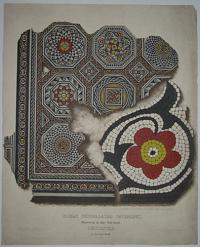
Roman Tessellated Pavement, Discovered in Jury Wall Street, Leicester, in the Year 1830.
W. Bowman, York. Fac simile from the Floral Border of the middle octagon in the upper row.
London: Published by Henry Ecroyd Smith, March 1st. 1850. Agent I.R. Smith 4 Old Compton Street. Printed in Colors by Standidge & Co. Old Jewry, Scale One Inch to the Foot.
Coloured lithograph, rare, 623 x 509mm. 24½ x 20". Some repaired tears and soiling around the edges.
The Roman mosaic found in a dark cellar of a house in Jewry Wall Street, Leicester. Ex Collection: Norman Blackburn.
[Ref: 19814] £180.00
(£216.00 incl.VAT)
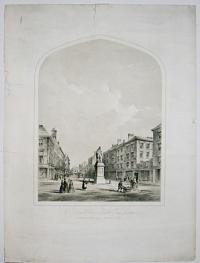
The Rutland Statue, Market Place, Leicester. Inaugurated 28th April, 1852 _ Edward Davis, Sculpt.r
Crane del et lith.
[n.d. c.1853.]
Lithograph, scarce. 680 x 508mm. 26¾ x 20". Some tears around the edges; laid on conservation tissue.
The statue of John Henry Manners, 5th Duke of Rutland (1778-1857) was unveiled in 1852 to celebrate his 50th anniversary as Lord Lieutenant of the county. It was the first public statue ever to be erected in Leicester. He generously gave money to deserving local charities and supported the Leicester Royal Infirmary in its early days; he was also a trustee of the British Museum.
[Ref: 23922] £160.00
(£192.00 incl.VAT)
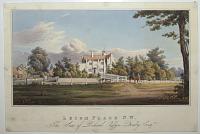
Leigh Place N.W. The Seat of Richard Caffyn Dendy Esq.r.
Drawn by G. Hawkins.
Rare lithograph 8 x 12" (205 x 305mm). Some surface dirt and cockled in areas outside the image where previously glued to sheet.
A north western view of Leigh Place in Surrey (built c.1810), the estate of Richard Caffyn Dendy (c.1758-1832). The house is surrounded by a moat and a white bridge crosses over. Two people stand next to the bridge in conversation, one sat on a horse the other carrying a gun probably having just come back from a hunt as there is an animal splayed at their feet, possibley a tired dog. Another larger dog stands close to it's master.
[Ref: 54775] £160.00
(£192.00 incl.VAT)
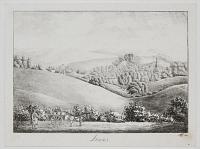
Lewes.
MS 1821.
Rare & early lithograph, very scarce. 191 x 260mm (7½ x 10¼").
A view from the road towards Lewes, set amongst the hills of East Sussex; Lewes Castle seen on the hill, and the River Ouse to the left. Ex collection of the Hon. Christopher Lennox-Boyd.
[Ref: 34790] £120.00
(£144.00 incl.VAT)
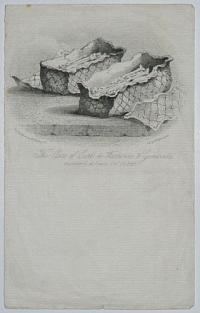
"The Cists of Earl de Warrenne & Gundrada," discovered at Lewes, Oct.r 28, 1845.
Eng. by J, Newman, 48, Watling St.
Pub. by W. Page, Lewes. [n.d. c.1825.]
Etching. 184 x 114mm. 7¼ x 4½".
The tombs and remains of William de Warenne, 1st Earl of Surrey (d. 1088), a Norman noble who fought at the Battle of Hastings, and his wife Gundrada (d. 1085), probably born in Flanders. They both founded a Cluniac Priory at Southover, adjoining Lewes, where both were buried.
[Ref: 16825] £45.00
(£54.00 incl.VAT)
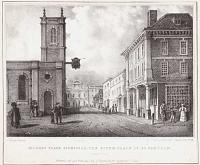
Market Place Lichfield, The Birth-Place of D.r Johnson.
Drawn, Lith.g and Published by N. Whittock, 39, Rathbone Place.
[n.d., c.1850.]
Lithograph. 150 x 180mm (6 x 7"). Trimmed close to image, laid on album paper at edges.
St. Mary's Church on the left, the Town Hall at the top of the street in the centre, and Samuel Johnson's birthplace on the right.
[Ref: 62532] £90.00
(£108.00 incl.VAT)

The South West Prospect of the City of Lichfield.
S. & N. Buck delin. et Sculp. 1732.
Engraving. Plate: 305 x 800mm (12 x 31½"). Central fold as issued, old ink mss. plate number. Slight offsetting in title at top.
A detailed prospect of Lichfield, with a descriptive text below and a key to the right. From the series 'Buck's Perspective Views of Cities and Chief Towns in England and Wales'; an early printing, before the addition of a plate number top right.
[Ref: 46971] £380.00

To the Rev. Henry White M.A. Sacristan of Litchfield Cathedral, This View of Johnson's Willow is inscribed by his obliged humble Servant John Hewitt.
Printed by C. Hullmandel. From a Sketch made in 1828.
Lichfield Aug. 1829.
Scarce lithograph. Sheet 365 x 280mm (14¼ x 11").
A view of an elderly willow by Stowe Pool, with the spire of Lichfield Cathedral behind. Planted c.1700, the willow was a favourite of Samuel Johnson, who described it as ''the delight of his early and waning life''. This print was published the year that it blew down, after which it was replaced by a cutting. In November 2021 a fifth replacement tree, all from cuttings, was planted.
[Ref: 58835] £230.00
(£276.00 incl.VAT)
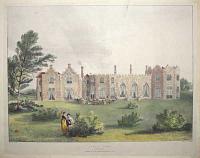
Lifton Park. South Front.
Drawn by Gendall. Printed by C. Hullmandel.
Published by Cole & Gendall, Artist's Repository, Exeter. [n.d. c.1840.]
Rare hand-coloured lithograph. 311 x 400mm (12¼ x 15¾"). Tear into upper image area. Tears to edges Cut and laid on paper.
Lifton Park, built c.1815 for William Arundell of Kenegie in Cornwall, in 1857 it was partly remodelled in a more archaeological but still Gothic style.
[Ref: 56069] £160.00
(£192.00 incl.VAT)
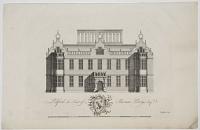
Lilford, the Seat of Thomas Powys Esq.r
T. Jeffrys Sculp:
[n.d. c.1791; but later.]
Engraving with large margins. Plate 221 x 305mm. 8¾ x 12".
From John Bridges' "History and Antiquities of Northamptonshire".
[Ref: 27602] £50.00
(£60.00 incl.VAT)
![[Advert.] In the Press, To be ready for delivery on the 1st of March, 1819, an Illustration of the Architecture and Sculpture of the Cathedral of Lincoln, Consisting of Sixteen Plates...](img-thumbnail/jpegs/48120.jpg)
[Advert.] In the Press, To be ready for delivery on the 1st of March, 1819, an Illustration of the Architecture and Sculpture of the Cathedral of Lincoln, Consisting of Sixteen Plates...
From Drawings by C. Wild.
Henry Sawyer, Engraver and Printer, Dean Street Soho. [1819.]
Letterpress advert. Sheet: 210 x 135mm (8¼ x 5¼'').
An advert for a series of prints after C. Wild of Lincoln Cathedral, the advert lists the engravers, various prices. The series 'consist of a Geometrical Plan, and Longitudal Section; various Elevations and Details; exterior and interiors Views; and Selections from the Sculpture'.
[Ref: 48120] £60.00
(£72.00 incl.VAT)

To the right Hon.ble and truly Noble Lord Thomas Viscount Weymouth & Baron of Warminster This 30 Table Shewing the W.N.W. Prospect of the Fair City of Lichfield taken near Units. Well with all dutifull observance is humbly presented by R.P.L.L.D. Tab, XXX. ad Pag.368.
M. Burghers. deling. et sculp.
[Robert Plot, 1686.]
Engraving. Plate 260 x 431mm. 10¼ x 17". Vertical crease and fold through centre as normal.
Taken from "The Natural History of Staffordshire". A west north west prospect of Lichfield, Staffordshire. Cows graze in the foreground; Lichfield Cathedral is the only medieval English cathedral left with three spires.
[Ref: 18462] £120.00
(£144.00 incl.VAT)
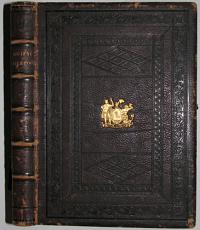
Pictorial Relics of Ancient Liverpool. Accompanied with Descriptions of the Antique Buildings, Etc. Compiled from Original Evidences, Private Muniments, and Unpublished Collections. By William Gawin Herdman, Author of The Illustrated Book of Fleetwood; A Folio of Continental Sketches; Ancient Liverpool, First Series; The Curvilinear Perspective of Nature; A Volume of Original Sacred Melodies, Etc. Etc.
Published by the Author. MDCCCLVII. [1857.] Liverpool: Printed by Henry Greenwood, Castle Street.
Subscriber's Copy. 4to (392 x 285mm. 15½ x 11¼"), blind-stamped full morocco gilt. Tinted lithograph title page and 49 plates, depicting 57 separate scenes (3 double-page) Cover slightly scuffed and rubbed; foxing across the pages.
A subscriber's copy of Herdman's larger compliation of drawings and images of Liverpool. Herdman (1805-82) was a self-taught painter who painted over 2000 watercolours on the environs of Liverpool. He exhibited at the RA from 1834-1861.
[Ref: 22108] £450.00
view all images for this item
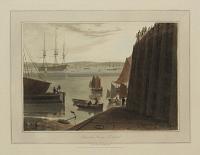
Seacombe Ferry, Liverpool.
Drawn & Engraved by Will.m Daniell.
Published by Mess.rs Longman, & Co. Paternoster Row, & W. Daniell, 9 Cleveland St. Fitzroy Square, London. Sept.r, 1, 1815.
Aquatint with fine original hand colour. 230 x 300mm (9 x 12"). Large margins, uncut.
A view of the port of the Seacombe Ferry in Liverpool, with a crowd standing on a high wooden jetty at the right, and figures near the water below. A ship with three masts is in background to the left, with hills in the distance. From William Daniell's 'A Voyage Round Great Britain', a series of 308 aquatints published in eight volumes between 1814-1825, described by R.V. Tooley as 'the most important colour plate book on British Topography'. Abbey: Scenery, 16; Tooley: Books with Coloured Plates 177.
[Ref: 36130] £190.00
(£228.00 incl.VAT)
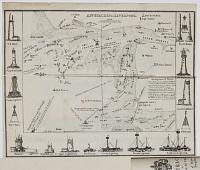
Approaches to Liverpool. 1847. [with] Abstract of The Act, 9 & 10 Vic., c.100. For the Regulation of Steam Navigation, and for requiring Sea-going Vessels to carry Boats.
J.B. Leatherbarrow, lithog. So J.n Street.
Lithographic map. 220 x 260mm (8¾ x 10¼"), 12pp. pamphlet pasted to edge. Splits in folds.
A guide to navigating into Liverpool's port, with coastal landmarks marked and illustrations of the lighthouses around three sides. The accompanying pamphet, published in Liverpool, outlines the new requirements for lifeboats.
[Ref: 37621] £80.00
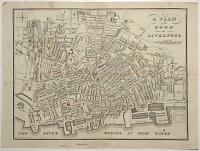
A Plan of the Town of Liverpool.
O'Connor Sculp.t 20 Rainsfords Gard.n.
[n.d., c.1800.]
Engraved map, 18th century watermark. On verso in ink Rich. Champney; 225 x 280mm (8¾ x 11"). Trimmed to plate top and bottom.
A detailed plan showing the docks.
[Ref: 56078] £160.00
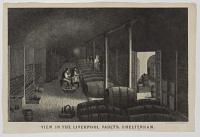
View in the Liverpool Vaults, Cheltenham.
Radclyffes & Co, Birmingham.
[n.d., c.1840.]
Engraving. Sheet 105 x 160mm (4¼ x 6¼"). Trimmed within plate.
The cellar of Mills Brothers wine merchant, in Regent Street, Cheltenham, filled with barrels and bottles on racks. Their merchandise would have been imported through Liverpool docks.
[Ref: 42065] £95.00
(£114.00 incl.VAT)

On the River Lodder. ''Sweet native Stream!'' _ Warton.
W. Delamotte del 1819. Lithography. Printed by F. Moser.
Lithograph, scarce. Sheet 280 x 385mm (11 x 15¼"). Paper toned.
A vew of a small river in a wood , a man sitting on the banks. The title contains a quote from Thomas Warton's 'To the River Loddon'.
[Ref: 44345] £140.00
(£168.00 incl.VAT)
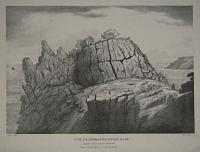
The Celebrated Logan Rock near the Land's End in Cornwall.
J. Tonkin delin: J.P. Vibert. Lithog:
Penzance. Published by Vibert & Tonkin Sep: 27. 1824.
Lithograph, sheet 345 x 470mm. 13½ x 18½". Horizontal crease.
The Logan Rock is an eighty ton granite boulder perched on the edge of a headland overlooking the Atlantic ocean one mile south of the Cornish village of Treen. It an example of a logan or rocking stone, being finely balanced due to the actions of weathering. The first plate from a set of six illustrating the events of 1824: in April Lieutenant Hugh Goldsmith (nephew of the famous poet Oliver Goldsmith) and ten or twelve of his crew of the cutter HMS Nimble rocked the huge granite boulder armed with bars and levers until it fell from its cliff-top perch. Goldsmith was apparently motivated to disprove the claim of Dr. Borlase, who wrote in 'Antiquities of Cornwall' in 1754 that "...the extremities of [the Rock's] base are at such a distance from each other, and so well secured by their nearness to the stone which it stretches itself upon, that it is morally impossible that any lever, or indeed force, however applied in a mechanical way, can remove it from its present situation". The displacement of the rock upset the local residents considerably, since Logan Rock had been used to draw tourists to the area. The Lords of the Admiralty were persuaded to lend Lieutenant Goldsmith the required apparatus for replacing it. The Admiralty sent thirteen capstans with blocks and chains from the dock yard at Plymouth, and contributed £25 towards expenses. After months of effort, at 4.20pm on Tuesday, the 2nd of November, 1824, in front of thousands of spectators and with the help of more than sixty men and block and tackle, the Logan Rock was finally repositioned and returned to "rocking condition". However, it apparently no longer vibrates or "logs" as easily as it did before the incident. Abbey Scenery: 106.
[Ref: 13518] £130.00
(£156.00 incl.VAT)
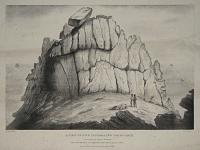
A View Of The Celebrated Logan Rock near the Land's End in Cornwall, taken after the Rock was displaced on the 8th of April, 1824.
J. Tonkin, delin. Vibert. lithog:
Penzance Pubs. by Vibert & Tonkin August 8th. 1824.
Lithograph, sheet 350 x 485mm. 13¾ x 19". Horizontal crease.
The Logan Rock is an eighty ton granite boulder perched on the edge of a headland overlooking the Atlantic ocean one mile south of the Cornish village of Treen. It an example of a logan or rocking stone, being finely balanced due to the actions of weathering. Plate 2 (numbered upper right) from a set of six illustrating the events of 1824: in April Lieutenant Hugh Goldsmith (nephew of the famous poet Oliver Goldsmith) and ten or twelve of his crew of the cutter HMS Nimble rocked the huge granite boulder armed with bars and levers until it fell from its cliff-top perch. Goldsmith was apparently motivated to disprove the claim of Dr. Borlase, who wrote in 'Antiquities of Cornwall' in 1754 that "...the extremities of [the Rock's] base are at such a distance from each other, and so well secured by their nearness to the stone which it stretches itself upon, that it is morally impossible that any lever, or indeed force, however applied in a mechanical way, can remove it from its present situation". The displacement of the rock upset the local residents considerably, since Logan Rock had been used to draw tourists to the area. The Lords of the Admiralty were persuaded to lend Lieutenant Goldsmith the required apparatus for replacing it. The Admiralty sent thirteen capstans with blocks and chains from the dock yard at Plymouth, and contributed £25 towards expenses. After months of effort, at 4.20pm on Tuesday, the 2nd of November, 1824, in front of thousands of spectators and with the help of more than sixty men and block and tackle, the Logan Rock was finally repositioned and returned to "rocking condition". However, it apparently no longer vibrates or "logs" as easily as it did before the incident. Abbey Scenery: 106.
[Ref: 13519] £130.00
(£156.00 incl.VAT)
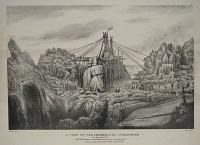
A View Of The Celebrated Logan Rock (near the Land's End) with the Machinery erected for the purpose of replacing it.
Tonkin. delin: Vibert, lithog:
Penzance. Published by Tonkin & Vibert. Novembr. 16 1824.
Lithograph, sheet 330 x 495mm. 13 x 19½". Two horizontal creases.
The Logan Rock is an eighty ton granite boulder perched on the edge of a headland overlooking the Atlantic ocean one mile south of the Cornish village of Treen. It an example of a logan or rocking stone, being finely balanced due to the actions of weathering. Plate 4 (numbered upper right) from a set of six illustrating the events of 1824: in April Lieutenant Hugh Goldsmith (nephew of the famous poet Oliver Goldsmith) and ten or twelve of his crew of the cutter HMS Nimble rocked the huge granite boulder armed with bars and levers until it fell from its cliff-top perch. Goldsmith was apparently motivated to disprove the claim of Dr. Borlase, who wrote in 'Antiquities of Cornwall' in 1754 that "...the extremities of [the Rock's] base are at such a distance from each other, and so well secured by their nearness to the stone which it stretches itself upon, that it is morally impossible that any lever, or indeed force, however applied in a mechanical way, can remove it from its present situation". The displacement of the rock upset the local residents considerably, since Logan Rock had been used to draw tourists to the area. The Lords of the Admiralty were persuaded to lend Lieutenant Goldsmith the required apparatus for replacing it. The Admiralty sent thirteen capstans with blocks and chains from the dock yard at Plymouth, and contributed £25 towards expenses. After months of effort, at 4.20pm on Tuesday, the 2nd of November, 1824, in front of thousands of spectators and with the help of more than sixty men and block and tackle, the Logan Rock was finally repositioned and returned to "rocking condition". However, it apparently no longer vibrates or "logs" as easily as it did before the incident. Abbey Scenery: 106.
[Ref: 13520] £120.00
(£144.00 incl.VAT)
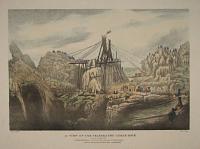
A View Of The Celebrated Logan Rock near the Land's End with the Machinery erected for the purpose of replacing it.
Tonkin. delin: Vibert, lithog:
Penzance. Published by Tonkin & Vibert. Novembr. 16 1824.
Original hand coloured lithograph, sheet 425 x 555mm. 16¾ x 21¾". Two horizontal creases.
The Logan Rock is an eighty ton granite boulder perched on the edge of a headland overlooking the Atlantic ocean one mile south of the Cornish village of Treen. It an example of a logan or rocking stone, being finely balanced due to the actions of weathering. Plate 4 (numbered upper right) from a set of six illustrating the events of 1824: in April Lieutenant Hugh Goldsmith (nephew of the famous poet Oliver Goldsmith) and ten or twelve of his crew of the cutter HMS Nimble rocked the huge granite boulder armed with bars and levers until it fell from its cliff-top perch. Goldsmith was apparently motivated to disprove the claim of Dr. Borlase, who wrote in 'Antiquities of Cornwall' in 1754 that "...the extremities of [the Rock's] base are at such a distance from each other, and so well secured by their nearness to the stone which it stretches itself upon, that it is morally impossible that any lever, or indeed force, however applied in a mechanical way, can remove it from its present situation". The displacement of the rock upset the local residents considerably, since Logan Rock had been used to draw tourists to the area. The Lords of the Admiralty were persuaded to lend Lieutenant Goldsmith the required apparatus for replacing it. The Admiralty sent thirteen capstans with blocks and chains from the dock yard at Plymouth, and contributed £25 towards expenses. After months of effort, at 4.20pm on Tuesday, the 2nd of November, 1824, in front of thousands of spectators and with the help of more than sixty men and block and tackle, the Logan Rock was finally repositioned and returned to "rocking condition". However, it apparently no longer vibrates or "logs" as easily as it did before the incident. Abbey Scenery: 106.
[Ref: 13521] £260.00
(£312.00 incl.VAT)
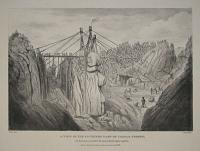
A View Of The Southern Part Of Castle Treryn, with the Machinery erected for the purpose of replacing the Logan Rock.
Tonkin, Delin: Vibert, Lithog:
Penzance, Published by Vibert & Tonkin November 16, 1824.
Lithograph, sheet 435 x 590mm. 17 x 23¼".
The Logan Rock is an eighty ton granite boulder perched on the edge of a headland overlooking the Atlantic ocean one mile south of the Cornish village of Treen. It an example of a logan or rocking stone, being finely balanced due to the actions of weathering. Plate 5 (numbered upper right) from a set of six illustrating the events of 1824: in April Lieutenant Hugh Goldsmith (nephew of the famous poet Oliver Goldsmith) and ten or twelve of his crew of the cutter HMS Nimble rocked the huge granite boulder armed with bars and levers until it fell from its cliff-top perch. Goldsmith was apparently motivated to disprove the claim of Dr. Borlase, who wrote in 'Antiquities of Cornwall' in 1754 that "...the extremities of [the Rock's] base are at such a distance from each other, and so well secured by their nearness to the stone which it stretches itself upon, that it is morally impossible that any lever, or indeed force, however applied in a mechanical way, can remove it from its present situation". The displacement of the rock upset the local residents considerably, since Logan Rock had been used to draw tourists to the area. The Lords of the Admiralty were persuaded to lend Lieutenant Goldsmith the required apparatus for replacing it. The Admiralty sent thirteen capstans with blocks and chains from the dock yard at Plymouth, and contributed £25 towards expenses. After months of effort, at 4.20pm on Tuesday, the 2nd of November, 1824, in front of thousands of spectators and with the help of more than sixty men and block and tackle, the Logan Rock was finally repositioned and returned to "rocking condition". However, it apparently no longer vibrates or "logs" as easily as it did before the incident. On J. Whatman watermarked paper 1824. Abbey Scenery: 106.
[Ref: 13522] £220.00
(£264.00 incl.VAT)
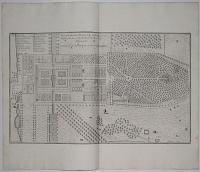
Plan of the Gardens, Plantations &c: of Long Leate in Wiltshire , the Seat of the Rt. Hon:ble the Lord Vis:t Weymouth. Les Jardins &c de Long Leate de dans l'Comte de Wilts. p: 63. Vol: 3.d [Key lettered A to W, top left-hand corner.]
Ca: Campbell Delin: H: Hulsbergh Sculp:
[n.d. c.1731.]
Copper Engraving. Plate 305 x 502mm. 12 x 19¾". Vertical fold through centre.
Garden plan from Henry Hulsberg's "Vitruvius Britannicus" series by c. Campbell. Thomas Thynne, 1st Viscount Weymouth (1640-1714) was a British peer, at Longleat, Wiltshire. A great Elizabethan house (1580) with garden and park. It once had an Elizabethan garden and a park designed by London and Wise in the 1680s, [See ref:18008]. Lancelot Brown re-designed them after 1757. It is noted for its Elizabethan country house, maze, landscaped parkland and safari park. See ref: 18011, 18008
[Ref: 18012] £260.00
(£312.00 incl.VAT)
![[Longleat] Long Leate in Wiltshire, The Seat of the Right Honourable the Lord Viscount Weymouth &c:](img-thumbnail/jpegs/58770.jpg)
[Longleat] Long Leate in Wiltshire, The Seat of the Right Honourable the Lord Viscount Weymouth &c:
Ca: Campbell Delin: H. Hulsbergh Sculp:
[n.d. c.1725.]
Engraving. 250 x 505mm (9¾ x 19¾"), large margins.
An elevation of Longleat, regarded as one of the finest examples of Elizabethan architecture, designed by Robert Smythson for Sir John Thynne and completed c.1580. Published in Colen Campbell's 'Vitruvius Britannicus'.
[Ref: 58770] £260.00
(£312.00 incl.VAT)

"Looe" - the ferry. [in pencil.]
Mabel Oliver Parker. [pencil signature.]
[n.d. c.1920.]
Etching. 216 x 311mm. 8½ x 12¼".
Looe, Cornwall. This old ferry goes along the Fowey estuary between Bodinnick and Polruan.
[Ref: 18060] £140.00
(£168.00 incl.VAT)

Port-looe, Cornwall.
Drawn & Engraved by Will.m Daniell.
Published by W. Daniell, Russell Place, Fitzroy Square, London May 20. 1825.
Aquatint with original hand colour. 230 x 300mm (9 x 12") large margins. Laid on card as usual.
A view of the port town of Looe. From William Daniell's 'A Voyage Round Great Britain', a series of 308 aquatints published in eight volumes between 1814-1825, described by R.V. Tooley as 'the most important colour plate book on British Topography'. Abbey: Scenery, 16; Tooley: Books with Coloured Plates 177.
[Ref: 47278] £180.00
(£216.00 incl.VAT)
![[East Looe and West Looe.]](img-thumbnail/jpegs/34725.jpg)
[East Looe and West Looe.]
[Drawn by J. Farington R.A. Engraved by W. Woolnoth.]
[London, Published May 1. 1813, by T. Cadell & W. Davies, Strand.]
Unfinished proof before all letters. Engraving with very large margins. Plate 229 x 280mm (9 x 11"). Small pinholes in image area.
A view or Looe, the small coastal town and fishing port in Cornwall. Looe is divided in two by the River Looe, East Looe and West Looe, connected only by the arched bridge, this was replaced by a newer seven-arched bridge in 1853. Plate 19 from 'Britannia Depicta: a Series of Views (with brief Descriptions) of the most interesting and picturesque Objects in Great Britain...' by Joseph Farington.
[Ref: 34725] £75.00
(£90.00 incl.VAT)
![[Louth] To the Worshipful the Warden and Assistants of the Corporation of Louth,](img-thumbnail/jpegs/51233.jpg)
[Louth] To the Worshipful the Warden and Assistants of the Corporation of Louth, This North West View of the Town of Louth is Inscribed By their obliged humble Serv.ts Tho.s Espin and Bart.w Howlett.
Drawn by Thomas Espin. Engraved by B. Howlett.
Publish'd as the Act directs April 17th [1793?] by John Jackson Lincolnshire.
Scarce etching. Sheet 430 x 585mm (17 x 23"). Trimmed within plate, some surface wear including loss of date, repairs left top corner.
A view of Louth, Lincolnshire, with workers harvesting hay in the fireground and a windmill on the far horizon. Thomas Espin (1767-1822) was an amateur artist who ran a 'Mathematical, Architectural, Nautical and Commercial Academy' in Louth. This plate was first published by the engraver, Bartholomew Howlett, in London, 1793; this example was issued by local Louth publisher John Jackson who operated until at least 1811. See BM 1870,0514.2877 for earlier version.
[Ref: 51233] £320.00
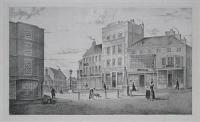
Louth Market Place.
On Stone by T.W. Wallis, Louth.
Printed by W. Monkhouse, York.
Rare lithograph. 250 x 390mm (15¼ x 11½"). Foxing around image and in title area.
The market place in Louth, Lincolnshire.
[Ref: 8794] £160.00
(£192.00 incl.VAT)
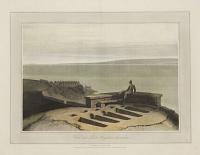
View near Lower Heysham, Lancashire.
Drawn & Engraved by Will.m Daniell.
Published by Mess.rs Longman, & Co. Paternoster Row, & W. Daniell, 9 Cleveland St. Fitzroy Square, London. March, 1, 1816.
Aquatint with fine original hand colour. On watermarked paper, 'J. Whatman. 1815'. 230 x 300mm (9 x 12"). Large margins, uncut.
A view depicting a man seated on a low stone wall overlooking Morecambe Bay. From William Daniell's 'A Voyage Round Great Britain', a series of 308 aquatints published in eight volumes between 1814-1825, described by R.V. Tooley as 'the most important colour plate book on British Topography'. Abbey: Scenery, 16; Tooley: Books with Coloured Plates 177.
[Ref: 36127] £160.00
(£192.00 incl.VAT)
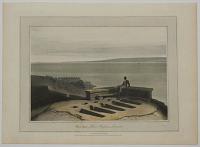
View near Lower Heysham, Lancashire.
Drawn & Engraved by Will.m Daniell.
Published by Messrs. Longman & Co., Paternoster Row & W.Daniell, 9 Cleveland Street, Fitzroy Square, London, March 1, 1816.
Hand coloured aquatint with large margins. Platemark: 230 x 290mm (9 x 11¼").
A man is seated on a low stone wall overlooking Morecambe Bay, near empty graves in the ground. From William Daniell's 'A Voyage Round Great Britain', a series of 308 aquatints published in eight volumes between 1814-1825, described by R.V. Tooley as 'the most important colour plate book on British Topography'. Abbey: Scenery, 16; Tooley: Books with Coloured Plates 177.
[Ref: 33887] £70.00
(£84.00 incl.VAT)
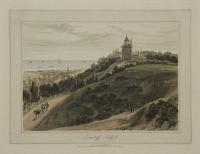
Lowestoff, Suffolk.
Drawn & Engraved by Will.m Daniell.
Published by Mess.rs Longman, & Co. Paternoster Row, & W. Daniell, 9 Cleveland St. Fitzroy Square, London. July, 1, 1822.
Aquatint with fine original hand colour. On watermarked paper, 'J. Whatman. 1821'. 230 x 300mm (9 x 12"). Mint, with large margins, uncut.
A view of Lowestoft from a hillside. A lighthouse is on a hilltop in the middle ground in the centre, with the town on the coast to the left. From William Daniell's 'A Voyage Round Great Britain', a series of 308 aquatints published in eight volumes between 1814-1825, described by R.V. Tooley as 'the most important colour plate book on British Topography'. Abbey: Scenery, 16; Tooley: Books with Coloured Plates 177.
[Ref: 36145] £190.00
(£228.00 incl.VAT)

![[Lewes Priory, Sussex] Confirmatio Radulfi de Pleiz Monachis sci Pancratii de Ecclesia et Terris in Iford &c. [Com: Sussex] in libera elemosina. circa tempus R. Stephani.](img-thumbnail/jpegs/24891.jpg)
![[Croxden Abbey, Staffordshire] Carta Abbatiae de Croxton in Com. Stafford, fundatae anno Dom. MCLXXIX [1179].](img-thumbnail/jpegs/24716.jpg)
![[Land grant, Cheshire] Carta Donationis Terrarum in Congilton [Com: Cestriae] a Dno Henrico de Lacy Comite Lincoln Benedicto Filio Walteri de Stanley.](img-thumbnail/jpegs/53132.jpg)
![Lavenham [pencil.]](img-thumbnail/jpegs/11649.jpg)

![[In ink:] The Regents Hotel Leamington.](img-thumbnail/jpegs/19111.jpg)

![Leeds from the Nostrop Road._ [in pencil.]](img-thumbnail/jpegs/15099.jpg)


















![[Advert.] In the Press, To be ready for delivery on the 1st of March, 1819, an Illustration of the Architecture and Sculpture of the Cathedral of Lincoln, Consisting of Sixteen Plates...](img-thumbnail/jpegs/48120.jpg)













![[Longleat] Long Leate in Wiltshire, The Seat of the Right Honourable the Lord Viscount Weymouth &c:](img-thumbnail/jpegs/58770.jpg)


![[East Looe and West Looe.]](img-thumbnail/jpegs/34725.jpg)
![[Louth] To the Worshipful the Warden and Assistants of the Corporation of Louth,](img-thumbnail/jpegs/51233.jpg)



